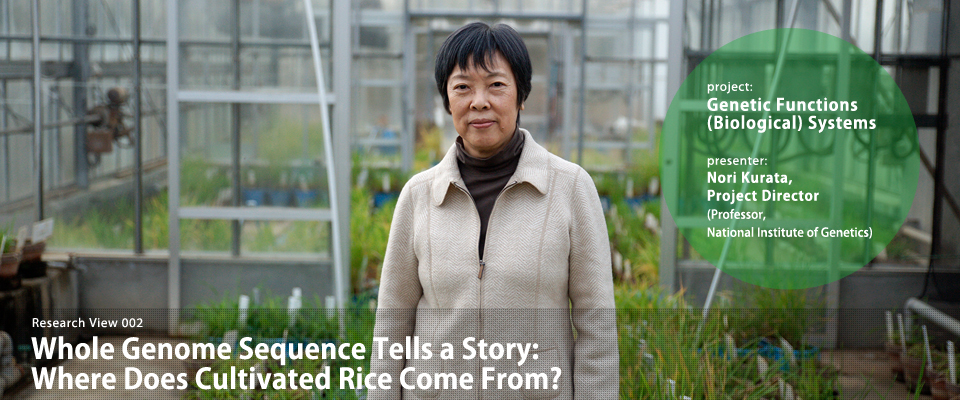Patiently confirming one’s own primary findings via continued and persistent hands on experimentation has been the traditional way of “practicing science” in biological research. The traditional approach has now partially been replaced due to the emergence of next-generation sequencers, which are able to generate an extensively greater volume of data, thereby heralding the arrival of the age of big data. Transdisciplinary Research Integration, a new field of research designed specifically to cater to the needs of the present times, involves the fusion of genome science and statistics and has already produced important results in various model organisms such as laboratory mice, Drosophila, the zebra fish, and rice. I would like to outline our research on “wild rice,” which is being developed further via data centric science, followed by our findings in 2012.

How is the genome linked to the variety of life?
Researchers are presented with a wide variety of genetic resources from various living organisms, which include information about the extremely varied forms that living organisms can assume. For example, in the case of rice, there is extensive information about the characteristics of various strains, such as the shape of flowers, the size of the fruit, and average plant length. Apart from this phenotypic data, there is also a large volume of genomic data. The genome is not simply a sequence of adenine (A), guanine (G), thymine (T), and cytocine (C) nucleotides, but it also includes information that allows coded genes to be read and expressed. Phenotypic changes in an organism in response to its environment or to external stimuli are influenced by its genome. However, it is difficult to determine exactly which piece of information (i.e. a specific gene) within the huge genome of an organism is responsible for a particular characteristic. The aim of our project is to establish a method that links genetic information to phenotypic characteristics and uncovers various relationships between them.

No project without the fusion of research fields
Overseas universities are equipped with departments that deal with statistics not only in the biological faculty, but also in almost all disciplines. In the biology discipline, there have been significant developments in the field of bioinformatics. In our joint project with the National Institute of Informatics, we used image processing to understand which information within the mouse genome relates to the shape of its chin. The difficulty in this case, however, is that computers are unable to distinguish differences that biologists can spot. It seems that human beings might be much better than computers at combining overall and detailed impressions. For processing by a computer, information about a mouse’s chin would need to be broken down into each individual element, for example, the element that decides the angle of the chin or the one that decides the shape of the tip and so on. However, we could make rapid progress once the separate elements were converted into numerical values that could be recombined to reconstruct the shape of the mouse's chin.

Why are the genome structures and related phenotypic characters of the wild species of rice still only barely understood?
Until now, research on rice under the umbrella of evolutionary science has dealt almost entirely with genetic analysis. Relevant agricultural research has been focused to develop techniques for its easy cultivation. The genetic succession of cultivated rice is now clear and, to a certain extent, we understand the relation between genes and their characteristics. However, wild species are quite scattered and have accumulated various natural variations. In addition, since accessions of wild rice evolved separately from those of cultivated rice, their hybridization is not simple. Hence, it has been difficult to deal with wild rice using existing genetic methodology. Therefore, we used association analysis to investigate statistical links between genome sequences and phenotypic characteristics for approximately 450 accessions of wild species of rice. This study was undertaken as a collaborative work between National Institute of Genetics and National Center for Gene Research/CAS in China. As an example, we checked for trends in the genome sequences of accessions that correspond to changes in characteristic data such as plant height and grain length.

Approaching data centric science
In addition to elucidating the relationships between the genome and the corresponding characteristics, our research indicating horizontal and vertical relationships (for e.g. which accession of wild species and strains of cultivated rice emerged first, and the kind of relationships indicated by regional distribution) was published in Nature magazine in 2012. We believe that this broadened knowledge about wild and cultivated rice was a significant necessary step towards studying genetic data in more detail. This has also proved influential in various ways. For example, it prompted a two- or three-fold increase in requests to the National Bio Resource Project (NBRP), which I am a part of, for wild accessions of rice from domestic and overseas researchers. However, it must be said that the real research starts now. Steady progress is being made with the study for the development of an analytical method undertaken jointly by the University of Tokyo and the Institute of Statistical Mathematics. However, there are still gaps in our knowledge about the kind of constituent elements each characteristic can be broken down into and their combination. We intend to refine the method further in these aspects.

(Text in Japanese: Nori Kurata, Rue Ikeya. Photographs: Mitsuru Mizutani. Published: April 1, 2014)




